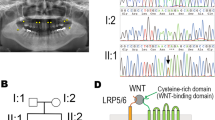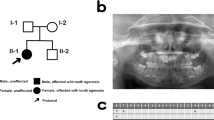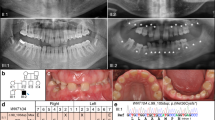Abstract
In this study we aimed to determine the effect of WNT10A variants on dental development in patients with oligodontia. Forty-three (25 boys and 18 girls) individuals were eligible for this study. Stage of development for each present tooth was assessed using the Demirjian method. In case no corresponding tooth was present, regression equations were applied for dental age to be calculated. The ratio between length of root and length of crown was ascertained for each present tooth in all quadrants. All patients were physically examined by a clinical geneticist and DNA analysis of the WNT10A gene was performed. Linear regression models were applied to analyze the association between WNT10A variants and dental age. The same analysis was applied to study the association between WNT10A variants and root elongation for each present tooth. One ordinal regression model was applied to analyze the association between WNT10A variants and development of present maxillary and mandibular teeth. Thirty-six (84%) patients were detected with WNT10A variants of which six patients displayed evident ectodermal features. Dental age was 1.50 (95% confidence interval (CI): −2.59, −0.42) to 1.96 (95% CI: −3.76, −0.17) years lower in patients with WNT10A variants compared with patients without variants. The development of maxillary canine, maxillary second molar and mandibular second molar was statistically significantly delayed in patients with WNT10A variants compared with patients without variants. The impact of WNT10A variants on dental development increases with presence of the nonsense c.(321C>A p.(C107*)) variant and the number of missing teeth.
Similar content being viewed by others
Log in or create a free account to read this content
Gain free access to this article, as well as selected content from this journal and more on nature.com
or
References
Silva Meza R : Radiographic assessment of congenitally missing teeth in orthodontic patients. Int J Paediatr Dent 2003; 13: 112–116.
Goodman JR, Jones SP, Hobkirk JA, King PA : Hypodonta 1: clinical features and the management of mild to moderate hypodontia. Dent Update 1994; 21: 381–384.
Kotecha S, Turner PJ, Dietrich T, Dhopatkar A : The impact of tooth agenesis on oral health-related quality of life in children. J Orthod 2013; 40: 122–129.
Polder BJ, Van't Hof MA, Van der Linden FP, Kuijpers-Jagtman AM : A meta-analysis of the prevalence of dental agenesis of permanent teeth. Community Dent Oral Epidemiol 2004; 32: 217–226.
Shimizu T, Maeda T : Prevalence and genetic basis of tooth agenesis. Jpn Dent Sci Rev 2009; 45: 52–58.
Khalaf K, Miskelly J, Voge E, Macfarlane TV : Prevalence of hypodontia and associated factors: a systematic review and meta-analysis. J Orthod 2014; 41: 299–316.
van den Boogaard M-J, Créton M, Bronkhorst Y et al: Mutations in WNT10A are present in more than half of isolated hypodontia cases. J Med Genet 2012; 49: 327–331.
Schalk-van der Weide Y : Oligodontia: A Clinical, Radiographic and Genetic Evaluation. Universiteit Utrecht: faculteit Geneeskunde, 1992; 7: 3–27.
Rushmah M : Hypodontia of the primary and permanent dentition. J Clin Pediatr Dent 1992; 16: 121–123.
Nieminen P : Genetic basis of tooth agenesis. J Exp Zool B Mol Dev Evol 2009; 312: 320–342.
Weide YSV, Beemer FA, Faber JAJ, Bosman F : Symptomatology of patients with oligodontia. J Oral Rehabil 1994; 21: 247–261.
Creton M, Cune M, Verhoeven W, Muradin M, Wismeijer D, Meijer G : Implant treatment in patients with severe hypodontia: a retrospective evaluation. J Oral Maxillofac Surg 2010; 68: 530–538.
Wong AT, McMillan AS, McGrath C : Oral health-related quality of life and severe hypodontia. J Oral Rehabil 2006; 33: 869–873.
Schalk-van der Weide Y, Steen WH, Bosman F : Taurodontism and length of teeth in patients with oligodontia. J Oral Rehabil 1993; 20: 401–412.
Tunc ES, Bayrak S, Koyuturk AE : Dental development in children with mild-to-moderate hypodontia. Am J Orthod Dentofacial Orthop 2011; 139: 334–338.
Uslenghi S, Liversidge HM, Wong FS : A radiographic study of tooth development in hypodontia. Arch Oral Biol 2006; 51: 129–133.
Ruiz-Mealin EV, Parekh S, Jones SP, Moles DR, Gill DS : Radiographic study of delayed tooth development in patients with dental agenesis. Am J Orthod Dentofacial Orthop 2012; 141: 307–314.
Ben-Bassat Y, Babadzhanov D, Brin I, Hazan-Molina H, Aizenbud D : Maturation of teeth adjacent to dental agenesis site. Acta Odontol Scand 2014; 72: 516–522.
Brook AH, Elcock C, al-Sharood MH, McKeown HF, Khalaf K, Smith RN : Further studies of a model for the etiology of anomalies of tooth number and size in humans. Connect Tissue Res 2002; 43: 289–295.
Kennedy DJ : Partial anodontia: a brief review and a case report of multiple familial incidence. Oral Surg Oral Med Oral Pathol 1950; 3: 63–73.
Vastardis H : The genetics of human tooth agenesis: new discoveries for understanding dental anomalies. Am J Orthodont Dentofacial Orthop 2000; 117: 650–656.
Kolenc-Fusé FJ : Tooth agenesis: in search of mutations behind failed dental development. Med Oral Patol Oral Cir Bucal 2003; 9: 390–395, 385-390.
Caton J, Tucker AS : Current knowledge of tooth development: patterning and mineralization of the murine dentition. J Anat 2009; 214: 502–515.
Cobourne MT, Sharpe PT : Making up the numbers: the molecular control of mammalian dental formula. Semin Cell Dev Biol 2010; 21: 314–324.
De Coster PJ, Marks LA, Martens LC, Huysseune A : Dental agenesis: genetic and clinical perspectives. J Oral Pathol Med 2009; 38: 1–17.
Mitsiadis TA, Smith MM : How do genes make teeth to order through development? J Exp Zool B Mol Dev Evol 2006; 306: 177–182.
Dhanrajani PJ : Hypodontia: etiology, clinical features, and management. Quintessence Int 2002; 33: 294–302.
Matalova E, Fleischmannova J, Sharpe PT, Tucker AS : Tooth agenesis: from molecular genetics to molecular dentistry. J Dent Res 2008; 87: 617–623.
Cobourne MT : Familial human hypodontia—is it all in the genes? Br Dent J 2007; 203: 203–208.
Bae CH, Kim TH, Ko SO, Lee JC, Yang X, Cho ES : Wntless regulates dentin apposition and root elongation in the mandibular molar. J Dent Res 2015; 94: 439–445.
Yang J, Wang SK, Choi M et al: Taurodontism, variations in tooth number, and misshapened crowns in Wnt10a null mice and human kindreds. Mol Gene Genomic Med 2015; 3: 40–58.
Chen J, Lan Y, Baek JA, Gao Y, Jiang R : Wnt/beta-catenin signaling plays an essential role in activation of odontogenic mesenchyme during early tooth development. Dev Biol 2009; 334: 174–185.
Fujimori S, Novak H, Weissenbock M et al: Wnt/beta-catenin signaling in the dental mesenchyme regulates incisor development by regulating Bmp4. Dev Biol 2010; 348: 97–106.
Massink MP, Creton MA, Spanevello F et al: Loss-of-function mutations in the WNT co-receptor LRP6 cause autosomal-dominant oligodontia. Am J Hum Genet 2015; 97: 621–626.
Arte S, Parmanen S, Pirinen S, Alaluusua S, Nieminen P : Candidate gene analysis of tooth agenesis identifies novel mutations in six genes and suggests significant role for WNT and EDA signaling and allele combinations. PLoS One 2013; 8: e73705.
Arzoo PS, Klar J, Bergendal B, Norderyd J, Dahl N : WNT10A mutations account for (1/4) of population-based isolated oligodontia and show phenotypic correlations. Am J Med Genet A 2014; 164A: 353–359.
Kantaputra P, Sripathomsawat W : WNT10A and isolated hypodontia. Am J Med Genet A 2011; 155: 1119–1122.
Adaimy L, Chouery E, Mégarbané H et al: Mutation in WNT10A is associated with an autosomal recessive ectodermal dysplasia: the odonto-onycho-dermal dysplasia. Am J Hum Genet 2007; 81: 821–828.
Nawaz S, Klar J, Wajid M et al: WNT10A missense mutation associated with a complete odonto-onycho-dermal dysplasia syndrome. Eur J Hum Genet 2009; 17: 1600–1605.
Bohring A, Stamm T, Spaich C et al: WNT10A mutations are a frequent cause of a broad spectrum of ectodermal dysplasias with sex-biased manifestation pattern in heterozygotes. Am J Hum Genet 2009; 85: 97–105.
Cluzeau C, Hadj‐Rabia S, Jambou M et al: Only four genes (EDA1, EDAR, EDARADD, and WNT10A) account for 90% of hypohidrotic/anhidrotic ectodermal dysplasia cases. Hum Mutat 2011; 32: 70–72.
Van Wijk AJ, Tan SPK : A numeric code for identifying patterns of human tooth agenesis: a new approach. Eur J Oral Sci 2006; 114: 97–101.
Creton MA, Cune MS, Verhoeven W, Meijer GJ : Patterns of missing teeth in a population of oligodontia patients. Int J Prosthodont 2007; 20: 409–413.
Demirjian A, Goldstein H, Tanner JM : A new system of dental age assessment. Hum Biol 1973; 211–227.
Nyström M, Aine L, Peck L, Haavikko K, Kataja M : Dental maturity in Finns and the problem of missing teeth. Acta Odontologica 2000; 58: 49–56.
Leurs IH, Wattel E, Aartman IHA, Etty E, Prahl-Andersen B : Dental age in Dutch children. Eur J Orthod 2005; 27: 309–314.
Nordgarden H, Jensen JL, Storhaug K : Oligodontia is associated with extra-oral ectodermal symptoms and low whole salivary flow rates. Oral Dis 2001; 7: 226–232.
Song S, Zhao R, He H, Zhang J, Feng H, Lin L : WNT10A variants are associated with non-syndromic tooth agenesis in the general population. Hum Genet 2014; 133: 117–124.
Russell BG, Kjær I : Tooth agenesis in Down syndrome. Am J Med Genet 1995; 55: 466–471.
Nolla CM : The development of the permanent teeth. J Dent Child 1960; 27: 254–266.
Briffa K, Busuttil Dougall N, Galea J, Mifsud D, Camilleri S : Chronologic and dental ages of Maltese schoolchildren: a pilot study. MMJ 2005; 33: 36–40.
Kumaresan R, Cugati N, Chandrasekaran B, Karthikeyan P : Reliability and validity of five radiographic dental-age estimation methods in a population of Malaysian children. J Investig Clin Dent 2014; 7: 102–109.
Nadler GL : Earlier dental maturation: fact or fiction? Angle Orthod 1998; 68: 535–538.
Holtgrave EA, Kretschmer R, Müller R : Acceleration in dental development: fact or fiction. Eur J Orthod 1997; 19: 703–710.
Acknowledgements
We thank colleagues in the Department of Medical Genetics and Oral and Maxillofacial Surgery, Prosthodontics and Special Dental Care in the University Medical Centre Utrecht for the referral of patients and molecular analysis performance.
Author information
Authors and Affiliations
Corresponding author
Ethics declarations
Competing interests
The authors declare no conflict of interest.
Additional information
Supplementary Information accompanies this paper on European Journal of Human Genetics website
Supplementary information
Rights and permissions
About this article
Cite this article
Dhamo, B., Fennis, W., Créton, M. et al. The association between WNT10A variants and dental development in patients with isolated oligodontia. Eur J Hum Genet 25, 59–65 (2017). https://doi.org/10.1038/ejhg.2016.117
Received:
Revised:
Accepted:
Published:
Issue date:
DOI: https://doi.org/10.1038/ejhg.2016.117
This article is cited by
-
New evidence for associations between vitamin D receptor polymorphism and obesity: case-control and family-based studies
Journal of Human Genetics (2020)
-
Prevalence of WNT10A gene mutations in non-syndromic oligodontia
Clinical Oral Investigations (2019)



